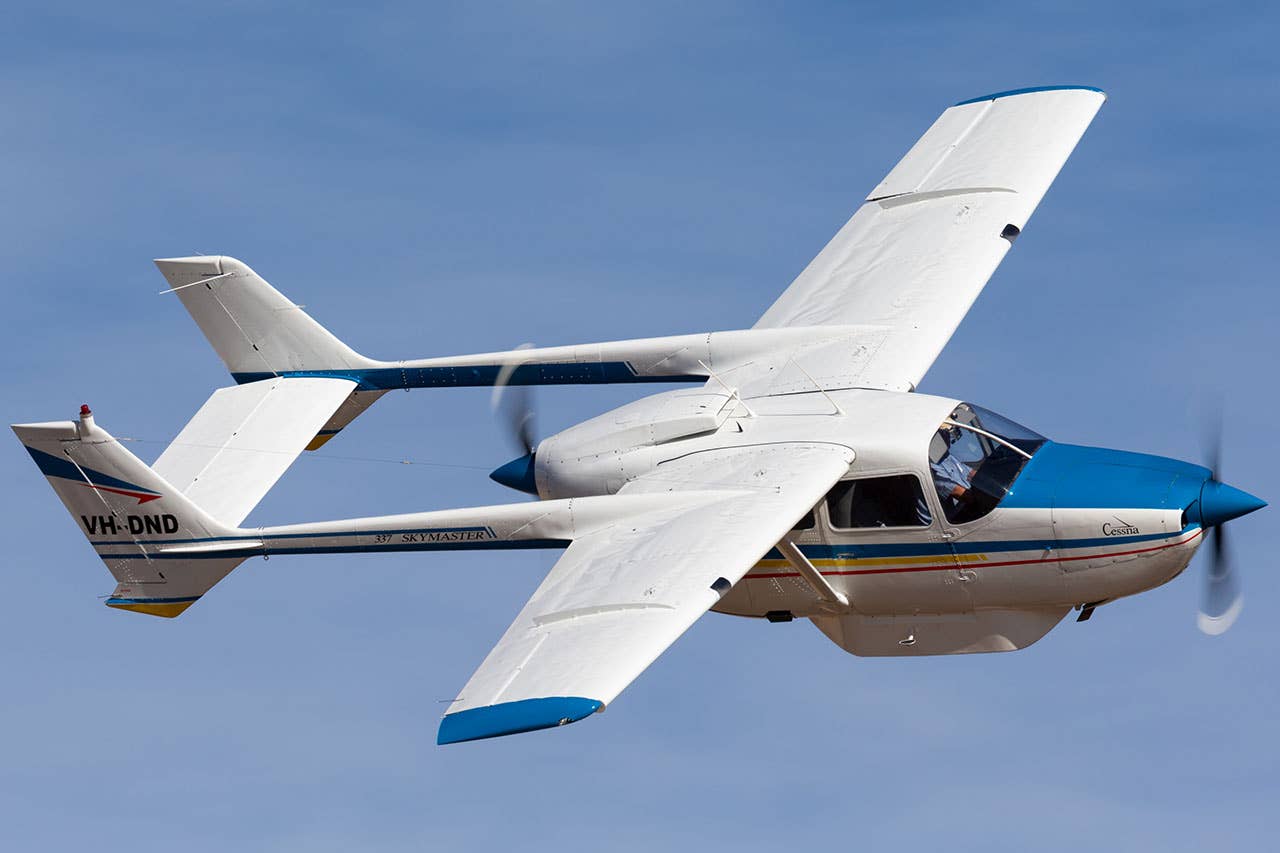Woman Survives 28,000 Foot Freefall After Plane Breaks Up
The mystery was twofold: What caused the crash, and how did she survive?

The pilot of the accident airplane, a Cessna 337 Skymaster similar to this one, flew the airplane at unusually high altitudes, which exacerbated the servicing issue that turned out to be behind the tragedy, though not the mystery of its crash.
Mystery
On April 1, 1997, a Cessna 337D Skymaster entered into an uncontrolled descent from 28,000 feet after the pilot suffered hypoxia and succumbed. The plane broke up and fell to the earth in pieces, yet the passenger survived with barely a scratch. How in the world is that possible?
Background
On a beautiful VMC day in April of 1997, a private pilot with around 3,100 flight hours took off on a mission to collect aerial imagery with his photography assistant. Departing from Waynesburg, Pennsylvania (WAY), in a Cessna 337D Skymaster (N2685S), they shot a few locations and landed at North Lima, Ohio (4G4). There, they fueled up and took back off for home at 1:45 p.m. At approximately 10,000 feet, the pilot and his assistant put on their oxygen masks. Once they were properly secured, he reached back, opened the system valve, and observed as the indicator ring changed from red to green. The cool invisible gas began to flow, and all seemed well.
At about 20,000 feet, the pilot asked his passenger how she was feeling. At the time, she felt fine and reported such, but she soon after began feeling dizzy. She attempted to relay this to him but received no response. Assuming he was tuned into an ATC transmission, she decided to close her eyes, hoping it would provide some relief. According to her, that was the last thing she remembered.
ATC had cleared the pilot to 25,000 feet but became concerned when it observed him continue to climb to 27,700 feet. The aircraft leveled off briefly, then descended to 26,000 feet, where radar contact was lost. At this point, the Skymaster had entered into an uncontrolled descent and began breaking apart. Its left and right tail booms, right door, left wing outboard, vertical and horizontal stabilizers all ripped off from the airframe and rained down across a 3-mile radius over Hickory, Pennsylvania. The fuselage came to rest in a tree, approximately 30 feet above the ground. Inside, the pilot was found dead and his passenger unconscious. Remarkably, she had only suffered minor cuts and bruises.
The Cause---Hypoxia
Investigators found that the pilot, who had mistakenly been given a tank of compressed air instead of pure oxygen when he landed at 4G4, had died of hypoxia prior to impact. For whatever reason, his passenger was better able to survive the prolonged period of oxygen deprivation. How people react to hypoxic conditions can vary greatly and is largely dependent on body type, overall health and personal history. Had they remained airborne longer before entering the uncontrolled descent, her fate would have eventually been the same as his.
Size Matters
The real mystery on this one is how she was able to survive such a remarkable fall from the sky.
One theory has to do with her size; it seems that the smaller she was, the more likely she would have been to survive the impact. Studies have shown that heavier individuals are 80% more likely to die in a crash than individuals of average weight. This is partially due to being predisposed to other health issues, such as heart failure, but the primary reason lies in seatbelt safety. The greater a person's excess weight, the less effective the seat belt is. When that interaction is compromised, the individual is more likely to be fatally injured. Investigators of the Skymaster crash found that the passenger was wearing her seatbelt and that it had functioned properly, contributing to her survival.
Be Relaxed
If you've ever wondered why it seems like drunk drivers survive car accidents more often than others, it's because they do. In fact, they are 65% more likely to survive serious trauma than their sober counterparts. It all boils down to the body's reaction to stress. When a person sees a crash about to happen, their natural reaction is to tense up. This causes certain stress-related chemicals to be released and the body's muscles to constrict. The tighter the muscles, the more prone they are to injury. This is what makes drunk drivers more likely to survive. Unlike sober, alert individuals, they are often in a state of relaxation and oblivion at the time of a crash.
While the Skymaster's passenger was not intoxicated by alcohol, she was essentially intoxicated by oxygen deprivation. More importantly, she was unconscious, which meant her body was relaxed and better able to sustain the impact.
Land Softly
Based on Newton's Second Law of Motion, a fast change in momentum will result in a larger force placed on an object withstanding an impact. Softer landing surfaces slow the impact momentum, leading to less force being placed on the aircraft and persons within. Since the Skymaster's fuselage landed in a hickory tree rather than the harder ground below, it decreased force on the passenger, in turn increasing her odds of survival.
Conclusion
Many believe that when a person survives something so incredible as a nearly 30,000-foot fall from the sky, it can only be the result of a genuine miracle.
While divine intervention can't technically be ruled out, the probable conclusion is that the woman was just really, really lucky. So many factors were at play, and nearly all had to align perfectly for her to be able to walk away, and with barely a scratch! While the pilot's fate was a horrible tragedy, somehow his passenger was granted a second chance at life.
Interested in more Mysteries of Flight columns? Enjoy, "Can A Propeller-Driven Aircraft Break The Sound Barrier?"

Subscribe to Our Newsletter
Get the latest Plane & Pilot Magazine stories delivered directly to your inbox






